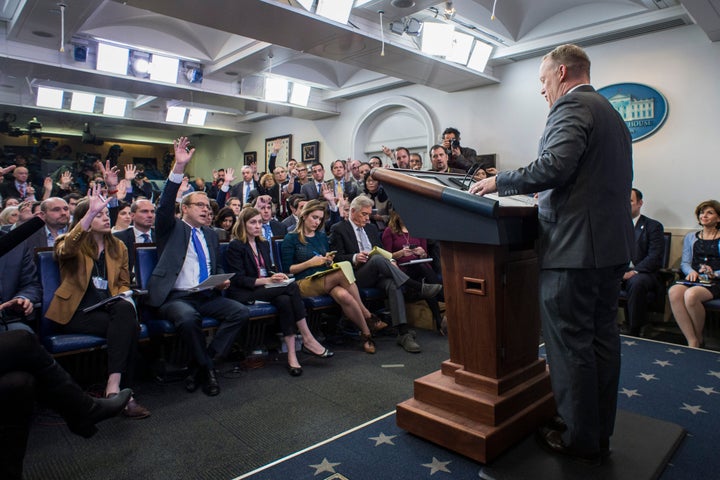White House press secretary Sean Spicer has warned for weeks that he wouldn’t hesitate to ditch press customs and even talked about moving briefings out of the White House space where they’ve been held for decades. And his first go-around behind the lectern on Monday didn’t disappoint.
Spicer bucked tradition by bypassing The Associated Press ― the customary recipient of the first question at the White House’s daily briefing ― and turning instead to the New York Post, the conservative-leaning tabloid owned by Rupert Murdoch.
Spicer followed by calling on a reporter from the Christian Broadcasting Network before working his way through members of the media tucked into the far reaches of the overly cramped James S. Brady Briefing Room. For traditionalists in the press corps, it was another sign that the Trump administration won’t abide by conventions of the past.
After all, Spicer’s first “official” briefing came just two days after he made a blistering statement against the media’s coverage of Donald Trump’s inauguration and echoed his boss by making false claims about crowd size. Spicer’s weekend tirade, which turned him into an internet meme, only escalated Trump’s “running war” with the media ― as the president has described it ― and heightened the drama around his first time taking questions from a packed room.
Spicer tried to laugh away the episode with a self-deprecating joke at the top of the briefing. But as the questions progressed, he largely defended his claims. “Our intention is never to lie to you,” he told ABC’s Jonathan Karl during one exchange.
That a press secretary had to utter those words during his first daily briefing doesn’t bode well for the administration’s relationship with the fourth estate. But Spicer’s actions on Monday suggest that he and Trump are eager to see an upending of that relationship in ways that could either democratize the White House briefing room or, conversely, create a more Pravda-like product.
In addition to disrupting the pecking order of questioners, Spicer also announced the creation of four “Skype seats” for daily briefings, which are to be filled by reporters at least 50 miles outside Washington. These virtual seats will allow “more access to a group of journalists from around the country,” he said. But it’s unclear how the occupants for those digital perches will be chosen.
Nor is it clear whether Spicer’s willingness to upend the questioning order will result in only the sympathetic members of the media getting called upon. The concern among reporters is that the Trump team may start turning to pro-Trump bloggers when the going gets tough. Such partisan or niche outlets could veer away from a major new story that has preoccupied the rest of the press corps.

While the Skype seats would allow distant and a potentially more varied group of journalists a chance to participate, it’s not as if only legacy media outlets are currently allowed inside the White House.
Digital news organizations, from The Huffington Post to Breitbart News, regularly attend briefings, even though they don’t have one of the 49 assigned seats. (HuffPost got a question in on Monday.) There are also journalists in the briefing room from little-known entities who make up the “other” White House press corps. One such regular, Raghubir Goyal, of the site India Globe, even got to ask the last question at Monday’s briefing.
The Trump team has emphasized the need to go beyond the traditional press corps and framed moving daily briefings to a nearby building as an effort to accommodate more journalists. But some reporters fear the move would lead to reporters no longer having any workspaces in the White House, along with traditional access to the communications team working in offices adjoining the briefing room.
Spicer complained last month that things had become “very stale” in the briefing room.
“All the mainstream media folks get front row seats, and it’s a question of, here are the broadcast networks, here’s The Washington Post, The New York Times,” Spicer said. “What about some of the conservative media having some of the prized seats in there?”
The seats remained the same Monday, but order of questioning didn’t.
Although Spicer’s first performance had many of the trappings of a typical briefing, with a wide range of questions and occasional sparring with high-profile correspondents, he made a statement by showing little deference to the front row.
Not only did Spicer turn first to New York Post reporter Daniel Halper, author of a critical book on the Clintons, he selected reporters at both the Murdoch-owned Fox News and Fox Business Network before turning the Big Three broadcast networks (ABC, NBC, CBS). That said, Spicer also called on reporters from American Urban Radio Networks and Univision before the three broadcast stalwarts.
It took more than an hour before Spicer called on CNN’s Jim Acosta, who Trump recently sparred with and refused to call on at a press conference. And it was another 10 minutes before Spicer picked Jeff Mason, a Reuters correspondent seated next to Acosta in the front row. Mason serves as president of the White House Correspondents Association.
In a later appearance on CNN International, Mason acknowledged Spicer mixing up the order.
“I think that that’s just a sign the Trump administration wants to shake things up a little bit,” Mason said. “And Sean Spicer, as the press secretary, did that a little bit in the briefing by rearranging how he calls on people.”
“But he did take questions from a lot of reporters in the room,” Mason added. “And that really is the biggest principle, that a lot of people have the chance to ask.”
